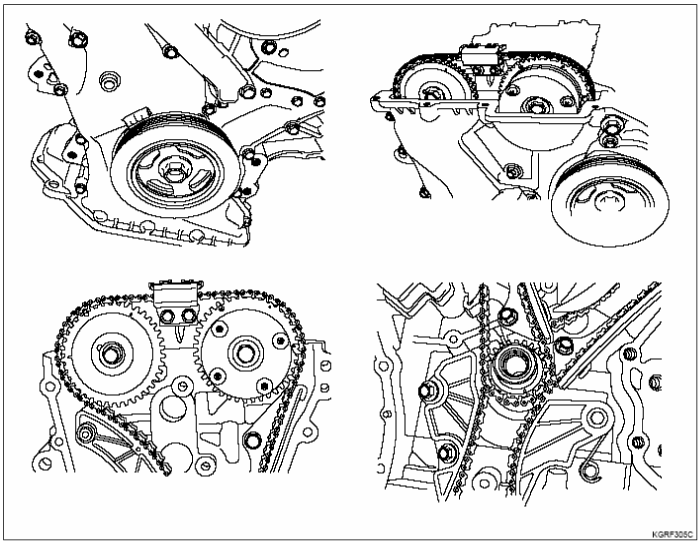Has a problem been found in any of the above areas ?
 | ▶ Repair or replace as necessary and go to "Verification of Vehicle Repair" procedure. |
 | ▶ Go to "Check Air Leakage" as below. |
Remove cylinder’s spark plugs.
Visually/physically inspect the following items:
▶ Damaged insulation, Worn electrodes, Oil or fuel fouled, Loose terminals and cracks.
▶ Check for plug gap : 1.0 - 1.1 mm (0.039 - 0.043 in.)
▶ Check if the spark plug for the relevant cylinder is lighter in color than the other plugs.
Has a problem been found in any of the above areas ?
 | ▶ Repair or replace as necessary and go to "Verification of Vehicle Repair" procedure. |
 | ▶ Go to "Check Air Leakage" as below. |
Visually/physically inspect the air leakage in intake/exhaust system as following items,
▶ Vacuum hoses for splits, kinks and improper connections.
▶ Throttle body gasket.
▶ Gasket between intake manifold and cylinder head.
▶ Seals between intake manifold and fuel injectors.
▶ Exhaust system between HO2S and Three way catalyst for air leakage.
Has a problem been found in any of the above areas ?
 | ▶ Repair or replace as necessary and go to "Verification of Vehicle Repair" procedure. |
 | ▶ Go to "Check for air leakage in Positive Crankcase Ventilation Valve(PCV)". |
Remove PCV valve from cylinder head cover by puling ventilation hose.
With engine idling block PCV valve opening.
Verify that vacuum is felt.
Remove PCV valve.
Blow through valve from prot "A" and verify that air comes out of prot "B".
Blow through valve from prot "B" and verifty that no air comes out of port "A".
Has a problem been found in any of the above areas ?
 | ▶ Repair or replace as necessary and go to "Verification of Vehicle Repair" procedure. |
 | ▶ Go to "Check Compression pressure" as below. |
Warm up the engine to normal operating temperature.
Disconnect the spark plug cables and remove the spark plugs.
Crank the engine to remove any foreign material in the cylinders.
Put compression pressure gauge into spark pulg hole.
Crank the engine with widely opend throttle valve and check compression pressure at each cylinder.
Specification : 1323kPa(13.5 kg/cm²,192 psi)
Is compression pressure for each cylinder displayed within specifications ?
 | ▶ Go to "Check Timing" as below. |
 | ▶ Add a small amount of oil through the spark plug hole, and repeat above steps. If the addition of oil causes the compression to rise, the cause is a worn or damaged piston ring or cylinder inner surface. ▶ If the compression remains the same, the cause is a burnt or defective valve seat, or pressure isleaking from the gasket. Repair as necessary and go to "Verification of Vehicle Repair" procedure |
IG "OFF".
Monitor these signal waveforms from CAM and Crank shaft position Sensor are correctly aligned.
Reference : The 17th of CKP signal from missing tooth is aligned with high of CMP signal.


Are all timing marks alligned correctly ?
 | ▶ Go to "Check Fuel Pressure" as below. |
 | ▶ Check that Cam, Crank and Oil pump sprocket timing marks are correctly aligned. Repair or readjust as necessary and go to "Verification of Vehicle Repair" procedure. |
Be cautious that Fuel is explosive and an empty fuel tank can still contain explosive gases. When working on fuel system make sure to supply adequate ventilation to the work area. Do not smoke, and keep sparks and open flames away.
The fuel system remains under pressure when the engine is not running. Release fuel system pressure before disconnecting any fuel line to reduce the chance of presonal injury or fire damage to vehicle components.
IG "OFF" and disconnect Fuel Pump Relay in Junction Box.
Start-up and wait until it stops itself.
IG "OFF" and connect Fuel Pump Relay.
Install the fuel pressure gauge to the delivery pipe with the fuel pressure gauge adaptor.
Activate the fuel pump, and with fuel pressure applied, check that there is no fuel leakage from the pressure gauge or connection part.
Measure the fuel pressure at idle.
Specification : 374.6 ~ 384.4 kPa(3.82 ~ 3.92 ㎏/㎠, 54.3 ~ 55.8 psi)
Is the measured fuel pressure within specifications ?
 | ▶ Substitute with a known - good ECM and check for proper operation. If the problem is corrected, replace ECM and go to "Verification of Vehicle Repair" procedure. note There is a memory reset function on scantool that can erase optional parts automatically detected and memorized by ECM. Before or after testing ECM on the vehicle, use this function to reuse the ECM on the others |
 | ▶ Repair or replace according to the below table. And then, go to "Verification of Vehicle Repair"procedure. |
Condition | Possible Cause |
Fuel Pressure is too low | Fuel filter, fuel pressure regulator, in-tank fuel hose or the fuel pump |
Fuel Pressure is too high | Fuel pressure regulator, hose or pipe |